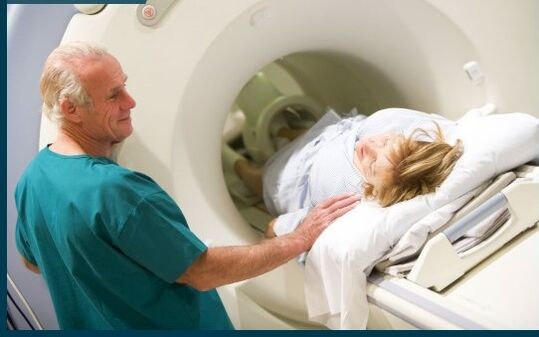Vertebral spine osteochondrosis is a degenerative-distribution pathology, characterized by damage to joint surfaces, intervertebral discs, muscle-giving appliances.The disease has a chronic course and is full of serious consequences.
The therapeutic effect of osteochondrosis is complex.The diagnosis timely of the disease is important - the sooner the therapy begins, the more likely a positive result.It is almost impossible to return degenerative processes, but you can stop them at the premiere stage.Progressive osteochondrosis can lead to protrusions, intervertebral disc hernias, neurological pathologies.
General information about the disease
Osteochondrosis is the most common spine disease and one of the most often diagnosed human pathologies of all existing ones.The disease can be considered as a peculiar hit of our type of revolt and the benefits of civilization.In animals, osteochondrosis does not have, since the spine of the spine is located horizontally.
If you have periodic or regular back pain in 75-80% of cases, these are manifestations of osteochondrosis.
In the thoracic region, degenerative changes develop less frequently than in the sacral and the cervicals of the back.Usually osteochondrosis in the thoracic region occurs after 40 years.The predisposing factors are excessive loads in the spine and a sedentary lifestyle.In the latter case, blood circulation and nutrition of cartilage and bone structures are disturbed, which leads to their gradual dystrophy.
In recent decades, doctors have observed the widespread "rejuvenation" of the disease.Osteochondrosis is diagnosed even in people aged 25 to 30, which is associated with a change in environmental status on the planet, as well as the nature of nutrition and the way of life of modern people.The presence of your own car, office work, the preference of passive relaxation on the computer is active-these factors do not contribute to the health of the musculoskeletal system.
The danger of breast osteochondrosis (and any other) is that it is almost impossible to restore the tissues of intervertebral discs: it means that segments affected by dystrophic and degenerative transformations are doomed to slow but inexorable destruction.The task of treatment for osteochondrosis is to interrupt the destruction of hard and soft tissues and minimize the risk of complications.
Characteristics of thoracic osteochondrosis
Thoracic zone osteochondrosis negatively affects human ability to make active movement.The progression of the disease is also full of hints from the nerve endings of the spinal cord, which inevitably affects the functional status of the internal organs.In advanced clinical situations of mammary osteochondrosis, it causes cardiac function, breathing problems.
The thoracic region is distinguished by low mobility;The load is not as large as in the neck and the lower back.Anatomically breast vertebrae are connected to ribs and sternum and jointly represent a sedentary and strong design, protected against external damage and influences.For this reason, mammary osteochondrosis rarely manifests itself in the early stage.The same circumstance determines the relative rarity of the diagnosis of "mammary osteochondrosis".
Provocative factors of the disease are usually injuries, posture violations, scoliosis and other anatomical disorders.Signs of thoracic osteochondrosis manifest very late, usually at the compression stage of the nerve roots.
How to manifest osteochondrosis in the chest
The first manifestation of the disease is the pain between the shoulder blades.The pain intensifies in loads or, conversely, manifests in the morning after a long stay in a position.Often, pain passes through the intercostal nerve and occurs when sneezing, cough, fast running.

Heart pains are possible, looking like an attack by Angina Pectoris and manifestation of heart failure.The similarity of symptoms with heart disease usually leads to an erroneous diagnosis.Sometimes symptoms resemble signs of bladder inflammation, ulcers or gastritis.To identify the true cause of pain manifestations, it is necessary to undergo a complete clinical diagnosis.
Other signs of thoracic osteochondrosis, besides pain:
- Neurological symptoms - a feeling of "goose bumps" on the skin in the chest and abdomen;
- Numbness of skin areas, impaired sensitivity;
- Heart violations, pelvic organs (with the development of spinal cord compression);
- Intercostal neuralgia - pain in ribs with a transition to sternum (develops in the form of seizures and is usually caused by lifting weights, hypothermia, stress);
- Dorsalgia - rigidity of the case muscles and pain during inhalation/expiration;
- Reflex muscle tension (the body tries to reduce the symptoms of pain due to physiological immobilization of the affected spine).
The more the disease lasts, the more it expresses its signs.It is important not to try to eliminate pain with painkillers and other medications, but determine its cause by clinical methods.Self -duty for osteochondrosis, at best, is useless and, at the worst, is dangerous and full of complications.
The Causes of Pathology
Doctors did not completely study the mechanisms that launched the process of tissue degeneration.It is assumed that osteochondrosis causes inadequate distribution of cargo on vertebrae with a weak muscle score of the back.The circumstances that increase the probability of the disease were clarified in detail.
The main factors of influence:
- Hypodinamia (sedentary work, a tendency to passive rest);
- Excessive loads due to the birth of the activity;
- Damage to the spine;
- Overweight;
- Heredity;
- Irrational nutrition;
- Curvature of the spine;
- Violation of posture, non -compliance with work hygiene;
- Metabolic pathologies;
- Dystrophic processes related to age in tissues;
- Constant exposure to vibration (for example, when working with a hammer monkey);
- Smooth feet;
- Walking in high shoes;
- Stress;
- Infectious diseases.
At risk of athletes, engines, truck drivers, builders and office workers.Most of the time, the disease has a multifactorial nature - a combination of several internal and external factors leads to its development.
The widespread opinion that osteochondrosis develops due to "salts" is incorrect from a scientific point of view.The calcification of discs and cartilage really occurs with degenerative diseases of the spine, but this is not the root cause, but a consequence of pathology.
Diagnostic methods
Identification of the disease begins with the initial examination of the patient, the study of information on symptoms, the patient's lifestyle, the nature of their nutrition and concomitant diseases.The palpation of the affected areas is performed.

The following diagnostic procedures are prescribed:
- General clinical test of blood and urine;
- Radiography;
- Ultrasound, magnetic resonance imaging and CT;
- MIELOGRAPHY - The introduction of contrast with the spinal cord to study its structure.
The most indicative diagnostic method is X -ray. Usually, the pointed radiography of specific spinal segments is performed.The images enable the identification of disc atrophy (reducing their thickness), the presence of osteophytes - bone growth, changes in the shape of the spine.
To exclude other pathologies with similar symptoms, consultations of cardiologists, gastroenterologists and other specialists (and relevant studies - ECG, gastroscopy) may be required.The main treatment is performed by an orthopedist or a vertebrologist - a spine specialist.
Modern Methods of Therapy for Thoracic Osteochondrosis
The therapeutic effect begins with the detection of the root cause of the disease.If this is an infection, treatment with antibiotics is performed if the weakness of the muscle device is performed measures to strengthen it.More often, treatment is outpatient, except for situations with a difficult clinic.
The main objective of treatment is to minimize degenerative processes and their consequences.Each specific case requires the preparation of an individual treatment regime, including effects of medicines, physical therapy methods and additional rehabilitation methods.They mainly practice conservative therapy, less commonly prescribed surgery.
Experienced doctors will never be undergoing treatment based on an isolated methodology or purely drug effects.Treating spine diseases with pills that eliminate pain symptoms is practice without a therapeutic perspective and a sign of a non -professional approach.However, it is impossible to pass completely without medication - especially at the acute stage of the disease.
Drug treatment
Apply the following groups of medicines:
- Painkillers;
- Anti -inflammatory drugs;
- Steroids;
- Muslaxantes to relieve spasms;
- Vitamins.
Preparations are mainly used at the early stage of treatment.They interrupt acute pain, eliminate inflammation (if any), stimulate metabolic processes.More often, medications are used externally (in the form of ointments), less frequently - within the form of tablets.It is even less necessary to make an injection into the affected area - this method is called "novocaine block".
Physiotherapy
Physiotherapeutic methods receive the lead role in degenerative chest backgrounds.These methods eliminate pain, inflammation, restoration of nutrition from affected tissues.Hardware and other exposure methods are used:
- Laser treatment;
- Magnetotherapy;
- AmplipultipulSterrapy;
- Ultrasound exposure;
- Balneotherapy (water treatment);
- Paraffin therapy;
- Mud;
- Hypothermia - cold therapy;
- Electrophoresis and phonophoresis.
The advantage of physiotherapy in its absolute security.This method has no contraindications for health reasons.The competent use of physical techniques provides a healing effect, even in the most difficult cases.
Independent Physiotherapeutic Method - Reflex therapy: Effect at body acupuncture points.The most famous way of reflexology is acupuncture.Cauterization is also performed, acupressure.It is proven that a competent effect on certain zones launches self -healing mechanisms, eliminates pain.
Therapeutic gymnastics
Exercise therapy is a method used for both osteochondrosis treatment and complication prevention.The exercise complex is selected individually.The goal of exercise therapy is to reduce pressure on nerve roots, strengthen ligaments and muscles, and prevent protrusions and hernias.

Gymnastics complexes should be performed under the guidance of a qualified instructor or in strict compliance with security rules.It is dangerous to overload the muscles;Therefore, the exercises should be accompanied by rest periods.
Manual therapy
Massage for osteochondrosis has the same goals as physiotherapy and therapy pain, improve the functionality of the ligament and muscle device and stimulates blood circulation.Professional competent massage seizes soft tissue nutrition and cartilage, accelerates regeneration processes.The use of mechanical devices - applicators, electrical masseurs and rollers is allowed.
A separate type of manual therapy is osteopathy.The method involves a specialist in diagnostic and therapeutic hand manipulations.This massage is distinguished by softness and physiologicity.Osteopathy eliminates tissue damage and has no age restrictions.
Diet
The main principles of the therapeutic diet for osteochondrosis: balance, the presence of all necessary trace elements, vitamins, a small number of calories.Another important criterion is the presence in the product menu responsible for the synthesis of the cartilage tissue in the body.These compounds are called mucopolysaccharides: the largest number of substances are contained in idiots, jam and flood dishes.
Radical therapy
In modern clinics, surgery with mammary osteochondrosis resorts extremely rarely.Operations may only be necessary if complications occur in the form of persistent root syndrome.Intervention can be attributed with the development of protrusions and hernias.
Prevention
It is much easier to prevent the disease than to perform long -term, sometimes long -term therapy.The prevention of osteochondrosis should be performed since childhood.Degenerative processes are impaired by: proper posture, dose of spinal cargo, compliance with safety during sports, rational nutrition, maximum flat surface sleep.Oporttoal detection of the first signs of the disease is important and the strict implementation of the doctor's recommendations.



















